Toucans of Costa Rica

My friends, visiting Costa Rica from much colder climates, jumped out of their restaurant seats at a sight of several Toucans in a nearby tree. To visitors, a Toucan is a symbol of wilderness, the jungle, and deep tropics, a very unusual animal that draws wonder. To us, living in Costa Ballena, Toucans have become an everyday sight, their distinct calls echoing across the landscape in the mornings and evenings. At times a dozen or more Toucans can be seen lounging in taller trees or following each other from treetop to treetop.

THE TOUCAN FAMILY OF COSTA RICA
While the Yellow-Throated Toucan is the most common specie, the Costa Rican Toucan family includes six greater Toucan family members: two ‘proper’ Toucan species, two ‘junior’ Toucans (called Toucanets) and two closely related species called Aracari. All very distinct in their own ways.

The Toucan family of birds tend to stay in place and are not fond of migrating. They predominantly feed on fruit but also are known to eat insects, lizards, rodents, and eggs and hatchlings – preferring to feed their chick a largerly ‘meat based’ diet due to the nutritional density of animal based meals. They nest in tree hollows left over by woodpeckers.
All six of the birds described further below, as is true of all Toucan family birds, wear bright and distinct colors, carry oversized beaks, and are fond of loud vocalizations. Thankfully none of the Costa Rican Toucan family birds are under threat and in fact may be doing better and better as Costa Rica undergoes a period of rapid re-forestation.
WHY THE HUGE BEAKS AND WILD COLOURS?
The Toucan beaks are huge for a reason – they provide a super efficient thermo-regulation system for the bird. Toucans control the blood flow to their beaks – the more hot blood is pumped in, the more heat is released. But that is not all – biologists speculate that the massive size may help the Toucans conserve energy, allowing the birds to reach many nearby fruit without the need to move or fly to nearby branches. It is also theoried that the big bill may help the Toucans access hard-to-reach food in crevices and hollows, and to intimidate smaller birds so that the Toucans can plunder their nests for eggs and chicks without being bothered.
The beaks may seem heavy and cumbersome but in reality they are light and spongy, made of hollow bone covered in keratin. They are also very soft and cannot be used for conventional ‘beak’ things like digging.
As for the colors – the wild mix of yellows, oranges, reds, green, blues and everything in between actually helps the Toucans blend into the rainforest canopies. Sounds counter-intuitive but its true!

CONVERGENT EVOLUTION
In an amazing case of convergent evolution, where species evolve independently and separately to resamble each other (eg shark, a fish and dolphin, a mammal that used to be ground based), thousands of miles away in Africa and SE Asia a family of birds evolved to resamble the Toucans and hold the same ecological niche in the African and Asian rainforests. These are the Hornbills.

YELLOW THROATED TOUCAN – Ramphastos swainsonii
This Toucan is the most common specie in our area, seen daily along the streets of Ojochal, local beaches, flying across the Costanera and even up into the slopes and cloud forests of the coastal mountains. They are most often seen in pairs or in flocks which can sometimes number in the dozens. These birds are big, loud, and unmissable with their contrasting colouring – a predominantly black body clashing with a vibrant yellow neck, head and bill-top area. The bottom of their bills are a deep chestnut colour while the bottom of their necks and undertail areas are bright red. They often love to perch on bare braches, making themselves very visible.

The Yellow-throated Toucan’s call begins with a loud, high-pitched yelp followed by several shorter, quieter bursts of sound. In Spanish, people describe the call as “Dios te de te de te de,” mimicking its rhythmic vocal pattern. This species prefers humid primary forests, mature secondary growth, and densely wooded parks or fruit plantations.
You won’t find it in Costa Rica’s elevated central regions or the drier Nicoya Peninsula due to habitat preferences. It’s also known as the Chestnut-Mandibled Toucan, a name that reflects its distinctive bill coloration and regional variation.
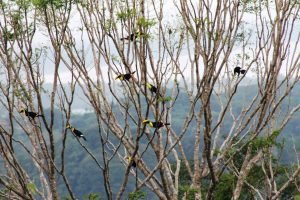
KEEL BILLED TOUCAN – Ramphastos sulfuratus
The Keel Billed Toucan amazes with its multi-coloured beak – vibrant green, yellow, orange, blue, purple and red shades make the beak look like a work of art. With the exception of the beak, the colouring of this bird is very similar to that of the Yellow Throated Toucan. The birds do not form lagrer flocks, often keeping to pairs or groups of 6-12 birds.
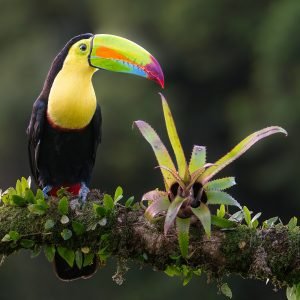
The call of a Keel Billed Toucan is a repeated frog-like croak which carries across the landscape.
Keel Billed Toucans can be found along the Carribean lowland forests, northern areas of the country and the Nicoya Peninsula – interestingly some of the very areas that are not hospitable to the Yellow-Throated Toucan. Also known as Sulfur-Breasted Toucan, Keel Toucan, or Rainbow-Billed Toucan.

EMERALD TOUCANET – Aulacorhynchus prasinus, and
BLUE-THROATED TOUCANET – Aulacorhynchus caeruleogularis
While not a ‘true’ Toucan, the Tuocanets are a part of the Toucan family and closely related, albeit much smaller and with a less pronounced beak. The two Toucanets – Emerald and Blue Throated – have been seen as two separate species but have now been merged into a single specie – although there is much disagreement about the classification. These two birds are very similar so will be described as a single specie.
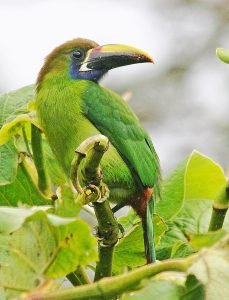
The Toucanets are a brightly coloured bird – the beak is yellow on top and black on the bottom, while the bird wears a green coat made up of many dazzling shades including greenish-yellow, light green, dark green, greenish-blue (especially around the neck) and deep emerald. The tail slowly fades into a blue shade with a reddish tip.
The call is a nasal, barking Wok!-Wok!-Wok!-Wok!-Wok!-Wok!-Wok!…“. It also makes a growling, throaty wra’a’a’a’a’a’ak“. Other vocalisations include a loud, far-carrying, dry rrip rrrip rrip rrip or curré curré curré…often continued for minutes on end. In flight the wings make a whirring sound.
These birds can be found along the central eelvated spine of Costa Rica, including the high mountian forests and cloud forests, and they are known to live up to an elevation of 3,000 metres – the exact areas where you will not find any of the country’s ‘true’ Toucans.

YELLOW-EARED TOUCANET – Selenidera spectabilis
This is the largest Toucanet, and the one with the most limited range in Costa Rica. The top of its beak is yellowish to olive green and the bottom is blackish to olive in colour. The top of the head is reddish brown while the bottom of the bird is black with splashes of yellow and red towards the back while the top is mostly green. There is a lot of vibrance around the eye – yellows, greens and emeralds encircle the eye and provide a bright contrast against the darker surrounding colors.

The call is a short to long series normally of double notes, tik-ett that is sometimes accompanied by bill snapping. Pairs sometimes sing simultaneously. It also makes long and short rattles that may be either vocal or made by the tongue inside the bill.
The Yellow-Eared Toucanet can be found in a strip along the Atlantic coast of Costa Rica, hugging the coast in the south and increasing further inland as one moves towards the north.
COLLARED ARACARI – Pteroglossus torquatus
This bird is names after a distinctive collar coloring along the back of its neck. Mostly black to greenish-black on top and yellow on the bottom, it has a black lower beak and yellowish-red upper beak that tapers towards black near the tip. A yellowish-red ‘collar’ extends around the upper part of its neck while a red and black band wraps around the yellow belly.

The call is a high, sharp, squeaky, note, such as seek, pseek, pink or penk, or a two-parted pi-cheet or squi-zeek. They also make a purr and an aggressive, rasping grhhrr. Collared Aracari’s wings make an audible whir during flight.
Collared Aracaris can be found along the Atlantic coast of Costa Rica, the northern areas of the country and the Nicoya Peninsula.

FIERY-BILLED ARACARI –Pteroglossus frantzii
This bird has a dazzling beak with a black lower half and a bright red upper half. The red tapers into yellow, then green, ending near the base with a distinct white line. That white line separates the beak from the rest of the bird’s body. Its head and upper body are mostly black, contrasting sharply with the vibrant chest and belly. Yellow feathers appear near the chest, shifting to red toward the tail with a clear color boundary.
The Fiery-Billed Aracari makes high-pitched calls like “pseep” and “sis-sik,” similar to the Collared Aracari. It also produces a croaking sound and a soft, rattling vocalization.
Fiery-Billed Aracaris can be found along the Pacific coast of Costa Rica with the exception of the Nicoya Peninsula. Their range then extends inland, into the coastal mountains, up to an altitude of about 1,800 meters.
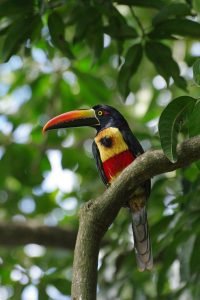
OUR LOCAL TOUCANS
Some Toucan species are said to be missing from Costa Ballena, but outdated range data may explain that claim. Costa Rica’s rapid reforestation allows animals once absent to return and repopulate former habitats, including this region. I’ve personally seen the Collared Aracari and Keel-Billed Toucan in Costa Ballena, despite reports they don’t live here. Learning Toucan traits helps us identify local species and share fascinating bird facts with curious guests and fellow nature lovers.
FAMOUS TOUCANS
Toucans are a favourite of logos, media and advertisers – here are some notable examples of very famous Toucans!




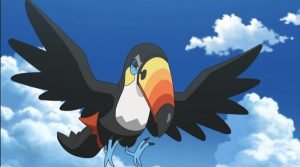
All photos except #1,6 courtesy of Wikicommons.
Do you dream of living in the midst of breathtaking tropical scenery and amongst amazing animals like the Sloths? At RE/MAX WE SELL PARADISE, we list hundreds of tropical properties. We have homes, land, farms, estates & businesses. All within a stone’s throw of the amazing rainforests, mountains, beaches and resident exotic animals that make Costa Ballena a world-famous destination. Start your journey to paradise by browsing our property listings here.



